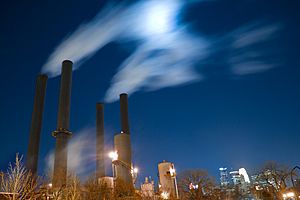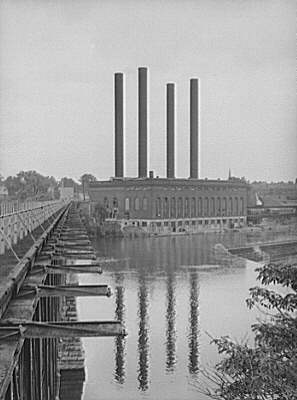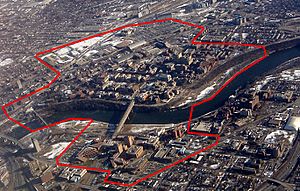Southeast Steam Plant facts for kids
Quick facts for kids |
|
|
Twin City Rapid Transit Company Steam Power Plant
|
|

View from the southwest
|
|
| Location | 600 Main Street SE, Minneapolis, Minnesota |
|---|---|
| Architect | Sargent and Lundy |
| Architectural style | Renaissance |
| NRHP reference No. | 94001385 |
| Added to NRHP | November 25, 1994 |
The Southeast Steam Plant is a special kind of power plant in Minneapolis, Minnesota. It makes both heat and electricity at the same time! This plant is located right on the Mississippi River and is owned by the University of Minnesota. It used to be called the Twin City Rapid Transit Company Steam Power Plant.
Contents
History of the Plant
This plant was built way back in 1903. Its main job was to create electricity for the Twin City Rapid Transit Company. This company ran the streetcars (like old-fashioned trains on city streets) that many people used to get around. The plant helped power public transportation for 50 years!
In the early 1950s, Minneapolis started using buses instead of streetcars. A company called Northern States Power Company bought the plant. Then, in 1976, the University of Minnesota bought it for just $1!
How the Plant Works
The Southeast Steam Plant is super important for the University of Minnesota. It heats 94 buildings on the Minneapolis campus. That's almost all of them! It also provides electricity to cool 19 of those buildings.
The plant also sends steam to other places nearby. These include the University of Minnesota Medical Center and the Minnesota State Board of Health.
Here's how it makes electricity: As the steam leaves the plant, its pressure is used to power machines that make electricity. This process creates about 20% of all the electricity the university needs. The plant's steam travels through 18 miles (29 km) of underground tunnels to reach the campus buildings. That's enough steam to heat 55,000 homes!
The University's Energy Management team oversees the plant. A company called Veolia North America has been operating it since 2016.
The university also has other ways to make power. Its Saint Paul, Minnesota campus has its own plant. Plus, there are backup generators and pumps that use diesel and natural gas. These are mostly used in emergencies or when a lot of power is needed.
Making the Plant Better
Working in the steam tunnels used to be very hot, sometimes 115 °F (46 °C)! Workers needed breaks every hour. But after new insulation was added, the tunnels became much cooler, around 80 °F (27 °C). This also helped the plant lose less energy, dropping from 10% to just 4%. Over time, this change helped the whole campus use 25% less energy!
In 2000, the university closed the Southeast plant for a big upgrade. They rebuilt the inside and then reopened it. This allowed them to close down an older power plant that burned only coal.
In 2005, the outside of the plant was also improved. This work even won a special award for keeping old buildings looking good!
Boilers, Fuel, and Emissions
The Southeast Steam Plant is known for being one of the "cleanest burning power plants" in the country. This means its high-temperature fires burn fuels almost completely. The plant uses several types of fuel: natural gas, fuel oil, coal, and wood waste.
They have also tested and been approved to use oat hulls as a biofuel. This is a renewable resource that could help save money.
The plant has four main boilers that are used. One large boiler, seven stories tall, can burn many different fuels like fuel oil, coal, wood, oat hulls, or natural gas. There are also two boilers that mainly use natural gas, and one that burns coal but can also use fuel oil.
The plant works hard to keep the air clean. It uses special equipment to control harmful gases like sulfur dioxide and tiny particles. It also emits almost no sulfur or mercury.
To keep things tidy, the areas where fuel is unloaded from trains are covered. The outdoor coal storage area has concrete walls to block wind. Even the ash storage areas have filters to prevent dust from escaping.
Concerns About the Plant
Some groups, like the Save Our Riverfront Coalition, wanted the plant to move away from the river in 1996. Important leaders, including the governor and mayor at the time, supported this idea.
Later, in 2005, some neighbors and a building developer were worried. They were concerned about possible emissions and noise if the plant started testing new fuels. However, the plant's permit was approved.
Biofuel Plans
In 2006, the Minnesota Pollution Control Agency said the plant could use biomass fuels, like oat hulls. However, it took three years to test and get approval for this. During that time, the company that supplied the oat hulls, General Mills (who makes Cheerios), found another buyer for them. So, the plant couldn't get the oat hulls it needed at that time.




